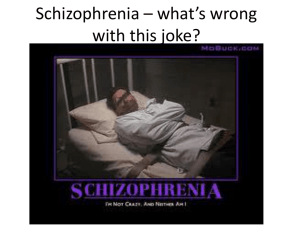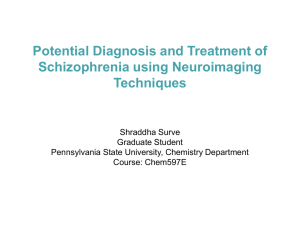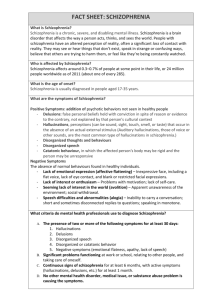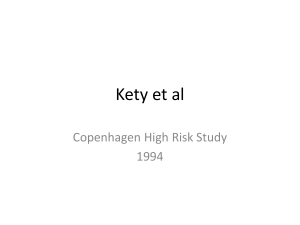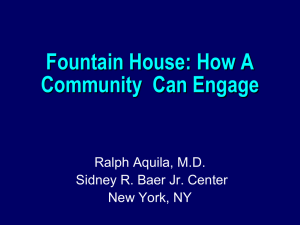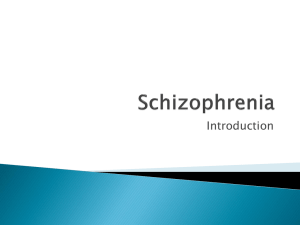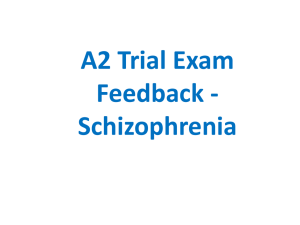Classification-MCQs
advertisement
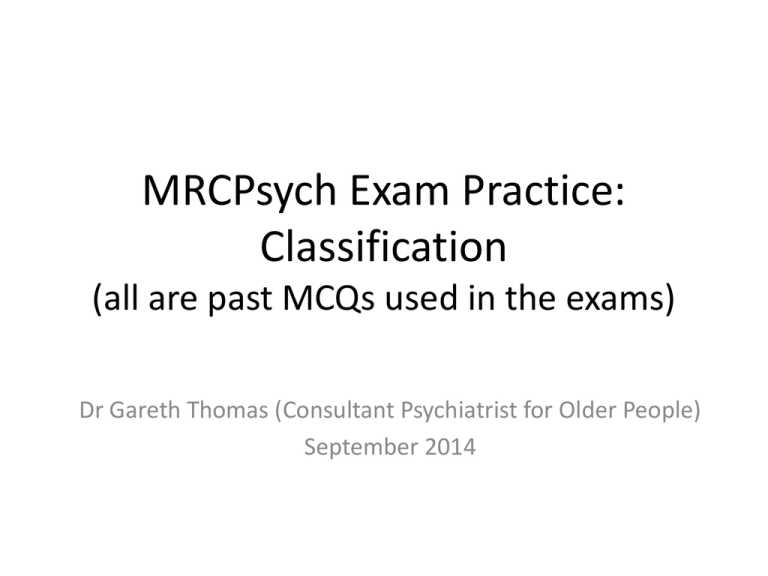
MRCPsych Exam Practice: Classification (all are past MCQs used in the exams) Dr Gareth Thomas (Consultant Psychiatrist for Older People) September 2014 1. Which of the following can be a discriminating symptom when making a clinical diagnosis? A. Poor concentration B. Psychomotor retardation C. Thought withdrawal D. Anhedonia E. Panic attacks 1. Which of the following can be a discriminating symptom when making a clinical diagnosis? A. Poor concentration B. Psychomotor retardation C. Thought withdrawal D. Anhedonia E. Panic attacks Explanation • Thought withdrawal is the delusion that thoughts have been taken out of the patient's mind • Other symptoms may be associated with other conditions, but thought withdrawal is associated with schizophrenia only • This is one of Schneider's first rank symptoms for schizophrenia (read) • These form the basis for the ICD10 criteria for Schizophrenia (read) • This is also a ‘positive symptom’ (read) 2 A 35 year old man has low mood, poor energy levels, anhedonia with associated loss of appetite, poor sleep and reduced libido. What is the severity of his depression? A. Mild B. Moderate C. Severe D. Dysthymia E. No depression 2 A 35 year old man has low mood, poor energy levels, anhedonia with associated loss of appetite, poor sleep and reduced libido. What is the severity of his depression? A. Mild B. Moderate C. Severe D. Dysthymia E. No depression Explanation • • • • Duration of at least 2 weeks Depressed mood, loss of interest and enjoyment and reduced energy are the core symptoms Other symptoms – Reduced concentration and attention – Reduced self-esteem and self-confidence – Ideas of guilt and unworthiness – Bleak and pessimistic views of the future – Ideas or acts of self-harm or suicide – Disturbed sleep – Diminished appetite Severity – Mild 2-3 symptoms – Moderate > 4 – Severe > 6 3. Which of the following subtypes of schizophrenia is classified in DSM, not ICD? A. Hebephrenic schizophrenia B. Paranoid schizophrenia C. Undifferentiated schizophrenia D. Disorganised schizophrenia E. Catatonic schizophrenia 3. Which of the following subtypes of schizophrenia is classified in DSM, not ICD? A. Hebephrenic schizophrenia B. Paranoid schizophrenia C. Undifferentiated schizophrenia D. Disorganised schizophrenia E. Catatonic schizophrenia Explanation 4. The following is true regarding persistent delusional disorder according to ICD-10? A. Delusions of more than 3 months duration B. Delusions incongruent to mood C. No hallucinations D. Single theme of delusions only E. Identifiable preceding stressor 4. The following is true regarding persistent delusional disorder according to ICD-10? A. Delusions of more than 3 months duration B. Delusions incongruent to mood C. No hallucinations D. Single theme of delusions only E. Identifiable preceding stressor Explanation • Persistent delusional disorder is characterised by a persistent delusion(s) • Transient auditory and visual hallucinations may occur but not as clear as in Schizophrenia • No blunting of affect • There is no necessity to have an identifiable stressor • DSM-IV specifies that symptoms should have been present for at least 1 month • ICD-10 specifies at least 3 months 5. A 40 year old woman had an episode of depression four years ago. For the last four weeks, she is low in mood, socially isolative and fears leaving the house in case she has a panic attack. She is tearful and not sleeping well. The most likely diagnosis is: A. Panic disorder B. Agoraphobia C. Depression D. Anxiety E. Dysthymia 5. A 40 year old woman had an episode of depression four years ago. For the last four weeks, she is low in mood, socially isolative and fears leaving the house in case she has a panic attack. She is tearful and not sleeping well. The most likely diagnosis is: A. Panic disorder B. Agoraphobia C. Depression D. Anxiety E. Dysthymia Explanation • In the exams, Depression almost always the answer if given the choice between Depression and Anxiety Any questions? Thanks.





